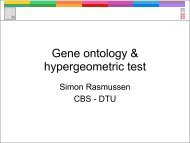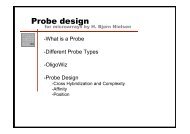Computational tools and Interoperability in Comparative ... - CBS
Computational tools and Interoperability in Comparative ... - CBS
Computational tools and Interoperability in Comparative ... - CBS
You also want an ePaper? Increase the reach of your titles
YUMPU automatically turns print PDFs into web optimized ePapers that Google loves.
10 O. N. Reva et al.<br />
encoded by a catabolic transposon (van Beilen et al.,<br />
2001) is remarkable: the Alcanivorax genes were probably<br />
acquired from the Yers<strong>in</strong>ia l<strong>in</strong>eage, whereas the<br />
P. putida genes exhibit the typical Alcanivorax tetranucleotide<br />
signature. Horizontal gene transfer was relevant to<br />
confer the – probably – most important metabolic trait to<br />
A. borkumensis, but otherwise the stable seawater habitat<br />
apparently did not favour the shuffl<strong>in</strong>g <strong>and</strong> exchange<br />
of genes with other taxa. Instead a symmetric <strong>and</strong><br />
structurally homogeneous chromosome evolved that<br />
lacks numerous metabolic traits (Yakimov et al., 1998;<br />
Schneiker et al., 2006) found <strong>in</strong> their versatile Pseudomonas<br />
relatives which are endowed with twofold larger chromosomes<br />
(Stover et al., 2000; Nelson et al., 2002).<br />
Experimental procedures<br />
Genomic sequence<br />
The comparative genomics analyses were based on the<br />
genomic sequence of A. borkumensis SK2 (Golysh<strong>in</strong> et al.,<br />
2003) <strong>and</strong> its annotation (Schneiker et al., 2006).<br />
Atlas visualization<br />
Atlases, developed <strong>in</strong> house, make it possible to visualize<br />
correlations between position dependent <strong>in</strong>formation conta<strong>in</strong>ed<br />
with<strong>in</strong> a chromosome. Circular graphical representations<br />
of the entire A. borkumensis genome were created<br />
us<strong>in</strong>g the atlas visualization tool, GeneWiz. Each feature,<br />
such as AT content is represented by a separate circle <strong>in</strong> the<br />
atlas. Typically, mean values are pictured <strong>in</strong> grey <strong>and</strong> extreme<br />
values are highlighted <strong>in</strong> a user def<strong>in</strong>ed colour (Pedersen<br />
et al., 2000).<br />
Phylome atlas. For each am<strong>in</strong>o acid sequence, phylogenetic<br />
trees were automatically constructed as described <strong>in</strong><br />
Sicheritz-Ponten <strong>and</strong> Andersson (2001). The phylogenomic<br />
<strong>in</strong>formation of the result<strong>in</strong>g 1919 phylogenetic trees was<br />
extracted <strong>and</strong> analysed <strong>in</strong> the PyPhy system.<br />
Genome atlas. The genome atlas is a comb<strong>in</strong>ation of some<br />
general <strong>in</strong>formative properties. These are some structural<br />
features (<strong>in</strong>tr<strong>in</strong>sic curvature, stack<strong>in</strong>g energy <strong>and</strong> position<br />
preference), some repeat properties (global direct <strong>and</strong><br />
<strong>in</strong>verted repeats) <strong>and</strong> the ma<strong>in</strong> base composition features<br />
(GC skew <strong>and</strong> percent AT).<br />
Intr<strong>in</strong>sic curvature was calculated us<strong>in</strong>g the CURVATURE<br />
software (Shpigelman et al., 1993). Stack<strong>in</strong>g energy of a<br />
DNA segment was determ<strong>in</strong>ed by the method of Ornste<strong>in</strong> <strong>and</strong><br />
colleagues (1978). Position preference was based on a tr<strong>in</strong>ucleotide<br />
model that estimates the helix flexibility (Satchwell<br />
et al., 1986). Base composition is generally divided <strong>in</strong>to AT<br />
content <strong>and</strong> GC skews. Both were calculated from the nucleotide<br />
sequence. Global direct <strong>and</strong> <strong>in</strong>verted repeats were<br />
found us<strong>in</strong>g variations of an algorithm that f<strong>in</strong>ds the highest<br />
degree of homology for a 15 bp repeat with<strong>in</strong> a w<strong>in</strong>dow of<br />
length 100 bp (Jensen et al., 1999).<br />
Codon <strong>and</strong> am<strong>in</strong>o acid usage<br />
Codon <strong>and</strong> am<strong>in</strong>o acid usage were calculated from all cod<strong>in</strong>g<br />
regions <strong>in</strong> the genome as annotated <strong>in</strong> the GenBank entries.<br />
The relative synonymous codon usage was calculated by<br />
compar<strong>in</strong>g the codon distribution from a set of highly<br />
expressed genes with a background distribution estimated<br />
from the codon usage of all cod<strong>in</strong>g regions <strong>in</strong> the genome<br />
(Willenbrock et al., 2006). In order to identify a set of constitutively<br />
highly expressed genes <strong>in</strong> A. borkumensis, the reference<br />
set of 27 very highly expressed Escherichia coli genes<br />
orig<strong>in</strong>ally compiled by Sharp <strong>and</strong> Li (1986) was aligned at the<br />
prote<strong>in</strong> level aga<strong>in</strong>st all genes annotated <strong>in</strong> the GenBank<br />
entry us<strong>in</strong>g BLASTP version 2.2.9 (Altschul et al., 1997). For<br />
each of these very highly expressed genes, the gene with the<br />
best alignment was added to a set of very highly expressed<br />
genes if it had an E-value below 10 -6 .<br />
TU patterns<br />
Overlapp<strong>in</strong>g tetranucleotide words were counted <strong>in</strong> the bacterial<br />
nucleotide sequences by shift<strong>in</strong>g the w<strong>in</strong>dow <strong>in</strong> steps of<br />
1 nucleotide. The total word number <strong>in</strong> a circular sequence<br />
equals to the sequence length. The observed counts of words<br />
(Co) were compared with the expected counts of words (Ce).<br />
Assum<strong>in</strong>g the same distribution frequency for all words irrespective<br />
of their composition <strong>and</strong> sequence mononucleotide<br />
content, Ce matches the ratio of the sequence length to the<br />
number of different tetranucleotide words Nw (256 for<br />
tetranucleotides).<br />
The deviation Dw of observed from expected counts is<br />
given by<br />
∆w= ( o−e)× o<br />
−<br />
C C C 1<br />
For the comparison of sequences by TU patterns, the words<br />
<strong>in</strong> each sequence were ranked by Dw values. Rank numbers<br />
<strong>in</strong>stead of word counts were used to simplify pattern comparison<br />
<strong>and</strong> to remove sequence length bias.<br />
The distance D between two patterns was calculated as<br />
the sum of absolute distances between ranks of identical<br />
words <strong>in</strong> patterns i <strong>and</strong> j as follows <strong>and</strong> expressed as a<br />
percent of the possible maximal distance:<br />
where<br />
D(<br />
% )= ×<br />
∑<br />
100 w<br />
D<br />
max<br />
rank − rank<br />
w, i w, i<br />
D<br />
max<br />
Nw( Nw−1)<br />
=<br />
2<br />
Dmax is the maximal distance that is theoretically possible<br />
between two patterns. For TU patterns Nw is 256. For more<br />
<strong>in</strong>formation about methods of oligonucleotide usage statistics<br />
see Reva <strong>and</strong> Tümmler (2004; 2005).<br />
Orig<strong>in</strong> plot<br />
The orig<strong>in</strong> plot was constructed as described <strong>in</strong> Worn<strong>in</strong>g<br />
<strong>and</strong> colleagues (2006). In brief, the difference between a<br />
hypothetical lead<strong>in</strong>g <strong>and</strong> lagg<strong>in</strong>g str<strong>and</strong> is plotted for various<br />
positions on the chromosome. The frequencies of all<br />
©2007TheAuthors<br />
Journal compilation © 2007 Society for Applied Microbiology <strong>and</strong> Blackwell Publish<strong>in</strong>g Ltd, Environmental Microbiology









